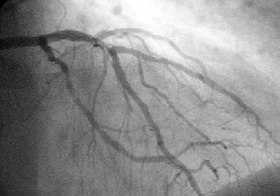| Percutaneous coronary intervention | |
|---|---|
 A coronary angiogram showing the circulation in the left coronary artery and its branches. | |
| Other names | Percutaneous transluminal coronary angioplasty (PTCA), coronary angioplasty[1] |
| ICD-9-CM | 36.09, 00.66 |
Percutaneous coronary intervention (PCI) is a minimally invasive non-surgical procedure used to treat narrowing of the coronary arteries of the heart found in coronary artery disease.[2] The procedure is used to place and deploy coronary stents, a permanent wire-meshed tube, to open narrowed coronary arteries. PCI is considered 'non-surgical' as it uses a small hole in a peripheral artery (leg/arm) to gain access to the arterial system; an equivalent surgical procedure would involve the opening of the chest wall to gain access to the heart area. The term 'coronary angioplasty with stent' is synonymous with PCI. The procedure visualises the blood vessels via fluoroscopic imaging and contrast dyes. PCI is performed by an interventional cardiologists in a catheterization laboratory setting.[3]
Patients who undergo PCI broadly fall into two patient groups. Those who are suffering from a heart attack and are in a critical care emergency room setting and patients who are clinically at a high risk of suffering a heart attack at some future point. PCI is an alternative to the invasive surgery coronary artery bypass grafting (CABG, often referred to as "bypass surgery"), which bypasses narrowed arteries by grafting vessels from other locations in the body. Coronary angioplasty was first introduced in 1977 by Andreas Gruentzig in Switzerland.[4]
- ^ George A Stouffer, III, MD (21 November 2016). "Percutaneous Coronary Intervention (PCI): Practice Essentials, Background, Indications". Medscape. Retrieved 22 January 2017.
- ^ Ahmad M, Mehta P, Reddivari AK, Mungee S (2023), "Percutaneous Coronary Intervention", StatPearls, Treasure Island (FL): StatPearls Publishing, PMID 32310583, retrieved 2023-11-21
- ^ "Coronary angioplasty and stents (PCI)". British Heart Foundation. Retrieved 2023-11-23.
- ^ Meier B (2001-01-11). "The First Patient to Undergo Coronary Angioplasty — 23-Year Follow-up". New England Journal of Medicine. 344 (2): 144–145. doi:10.1056/NEJM200101113440217. ISSN 0028-4793. PMID 11188421.